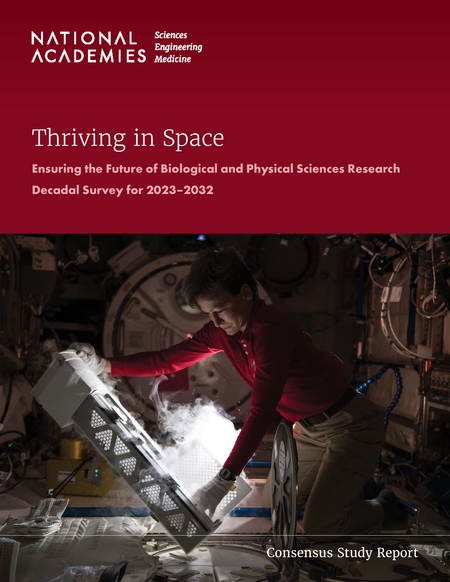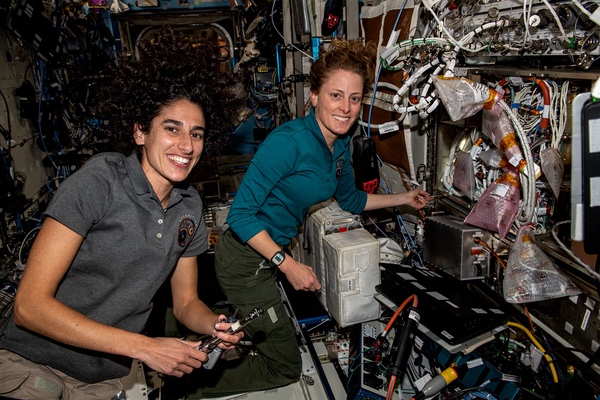An ambitious decadal survey for research in spaceby Jeff Foust
|
| The report concluded that, to achieve its goals, “the budget must rise by a factor of 10 well before the end of the decade.” |
The new decadal survey for biological and physical sciences in space, though, offered a different kind of ambition. Unlike NASA’s other science divisions, biological and physical sciences (BPS) does not have spacecraft missions of its own, but uses the International Space Station and other platforms to support research in its fields. And, the steering committee who led the decadal concluded, NASA needed more money to support that research.
A lot more money. Several issues, the report stated, “all drive toward the inescapable conclusion that to provide sustainability and visibility for the program, while funding the science needed to support the expansion of space activities prioritized by this survey, the budget must rise by a factor of 10 well before the end of the decade.” [Emphasis in original]
“It’s not just because researchers would like more funding to fuel our curiosity and our teams to answer important questions to us personally, and to the field,” said one of the co-chairs of the steering committee, Krystyn Van Vliet of Cornell University, “but because the key scientific questions that we’ve laid out are critical for us to answer in the coming decade if the US is to maintain a leadership position and, globally, we are to use the space environment responsibly.”
Speaking at an event last month at the National Academies to roll out the report, Van Vliet and the other co-chair, Robert Ferl of the University of Florida, laid out those scientific questions, which the survey placed into three categories. Once, called “Adapting to Space,” is focused on fundamental, primarily biological, changes to processes when in space. The second, “Living and Traveling in Space,” examines longer-term biological and physical science issues associated with the space environment, including creating sustainable habitats and using extraterrestrial resources. The third, “Probing Phenomena Hidden by Gravity or Terrestrial Limitations,” studies broader changes in biological or physical systems in microgravity or other aspects of space.
Those questions can be answered by a wide range of experiments, but the decadal survey focused on two “research campaigns” it recommended. “The idea of research campaigns for this community is a new one,” Ferl said. The intent was to do for biological and physical sciences what other decadals do when they recommend large missions.
“Our goal with the research campaigns was to capture and encapsulate some big goals, some big-question items that dealt with the key scientific questions, but put them together in a way that was scalable within the decade,” he said, “the idea that we could actually answer, at a large scale, key scientific questions that were meaningful in the exploration environment and also to the way things work here on Earth.”
The decadal recommended two such research campaigns. One called, Biorenegerative Life Support Systems, or BLiSS, would study various biological science questions to support development of self-sustainable systems. That would include, Van Vliet said, work towards closed-loop life support systems. “While we might not get there all the way in the coming decade, the progress laid out and traced in this research campaign allows the US to collaborate and compete in this space as will be required for space exploration goals.”
The other, known by the highly contrived acronym of MATRICES (Manufacturing mATeRIals and proCessEs for Sustainability in space) would be devoted to understanding how to use space resources to produce materials needed for space exploration. One of the goals of MATRICES, Ferl said, is to “establish a sustainable in-space economy by learning what it takes to manufacture much of what is needed.”
These campaigns were not linked to a specific platform, like the ISS. “We did not locate them in a specific space environment or a specific destination,” Van Vliet said. “We want to ask the questions where they are best asked.”
The report, though, did go into more detail about platforms and costs. It estimated BLiSS would cost about $1.7 billion over the next decade, primarily involving the ISS and commercial successors. MATRICES came in at $3.7 billion over the decade, again primarily using the ISS and commercial stations; it has higher costs for large experiment facilities that also drive up the costs to launch and accommodate them.
Those two research campaigns alone would cost NASA $5.4 billion over a decade, or $540 million a year on average. The BPS division has a current budget of just $85 million a year, thus becoming a key factor in the report’s recommendation for a massive budget increase. As the decadal concluded, “the campaigns cannot even be considered without the recommended increase in funding.”
That was not the only argument for increasing the BPS budget included in the report. The decadal also noted that, historically, NASA had spent much more on such research, approaching $700 million a year (when adjusted for inflation) in the mid-1990s, only to be all but wiped out by 2010. That steep reduction came from an agency decision to redirect funding to the Constellation program in the mid-2000s.
“In 2010, Constellation was canceled, but the funding for BPS was not restored and many researchers left the field,” the report stated. “A return to funding levels of the space shuttle era would target ~$700 million inflation-adjusted dollars in 2023.”
| Commercial providers, Van Vliet said at the briefing, offer new solutions “but also new challenges for prioritizing research over definite products and profit.” |
There was another argument as well involving the standing of BPS within the Science Mission Directorate, where the division was moved from NASA’s Space Operations directorate three years ago. At its current budget, BPS is barely one-tenth the size of the next largest science division, heliophysics, which received $805 million in 2023. Astrophysics, Earth science, and planetary science are far larger.
“Moreover, a budget nearer to $1 billion raises the profile of BPS science into the realm of the other divisions within NASA’s Science Mission Directorate (SMD), tangibly recognizing the tremendous human and commercial interest in space exploration, the expansion of the BPS program beyond low Earth orbit (LEO), and the development of the space economy,” the report concluded.
 The cover of the decadal survey report featured a photo of former NASA astronaut Peggy Whitson, in part because she illustrates the shift from government to commercial capabilities in orbit. (credit: National Academies) |
A new commercial world
The decadal spans a key period in research in space. At its start, 2023, the ISS is hitting its stride as a major research platform, but by 2032, the station is slated to no longer exist, having been deorbited and replaced by commercial stations, as well as other platforms from suborbital vehicles to the lunar Gateway and facilities on the surface of the Moon (see “Minding the space station gap”, The Space Review, August 7, 2023).
The report calls on NASA to “actively engage” with developers of commercial platforms “to ensure that science needs are met with clear priority, guaranteeing that national science needs are enabled along with those of potential commercial customers using those platforms.”
Commercial providers, Van Vliet said at the briefing, offer new solutions “but also new challenges for prioritizing research over definite products and profit.”
The acknowledge of that change, she added, included the report’s cover, which featured former NASA astronaut Peggy Whitson working on the ISS. “It’s not because she’s an amazing female astronaut and researcher—yes, she is—but she’s also crossed from the public sector to the private sector,” she said. Whitson is now at Axiom Space and commanded that company’s Ax-2 private astronaut mission to the ISS in May (see “A veteran astronaut adjusts to a new era of private spaceflight”, The Space Review, June 26, 2023).
There is another factor underlying the importance of commercial space stations, Ferl said. “It’s also clear that stations supported by other countries have a chance to outlive our current International Space Station.”
NASA, supporting work by teams led by four companies—Axiom Space, Blue Origin, Northrop Grumman, and Voyager Space—is also thinking about how to transfer research from the ISS to the commercial stations they are developing. In an interview before the release of the decadal survey, Lisa Carnell, director of the BPS division at NASA, said her division has been doing preparatory work, such as outlining all the current and planned ISS research facilities so that commercial station developers were aware of NASA’s research activities. “We wanted to give them the opportunity to see it all and see what their interests were in providing it,” she said.
The division has also been trying to help that transition to commercial stations. Last year, Carnell’s predecessor, Craig Kundrot, announced a program called Commercially Enabled Rapid Space Science, or CERISS. The vision of CERISS, he said, was to allow researchers to fly to the ISS on private astronaut missions to perform “hyper-specialized” science far more efficiently than if a NASA astronaut was trained to do so.
| “Change is hard, but it also brings a lot of opportunity and excitement,” Carnell said. “There will be some growing pains, but I do think it’s going to be a huge benefit for NASA and for the space industry.” |
Those plans, which envisioned flying researched by mid-decade, were predicated on BPS getting a modest budget increase in 2023: from $82.5 million to $100 million. However, that increase didn’t materialize, and the division got $85 million instead. “Our commercial initiative to work with industry to increase the pace of research ten- to hundred-fold in low Earth orbit is dialing back to just do analysis and planning this year,” Kundrot said at a NASA science town hall meeting in January.
Carnell said CERISS remained a priority in the long term, but wanted to see what recommendations, if any, the decadal made in the field. In the nearer term, she noted. Suborbital flights might provide other opportunities for research as precursors to private ISS missions: the Flight Opportunities program now funds researchers to fly with their payloads, while the Suborbital Crew program is studying how to enable civil servants to go on such flights.
“Change is hard, but it also brings a lot of opportunity and excitement,” she said of new research opportunities enabled by commercial platforms. “There will be some growing pains, but I do think it’s going to be a huge benefit for NASA and for the space industry.”
NASA is only beginning to review the decadal survey. Carnell said it would take her division, and SMD leadership, a few months to review the recommendations and chart a path forward. An initial response, including a town hall with the BPS research community, is tentatively planned for early next year.
At the briefing about the decadal, Nicola Fox, associate administrator for science, said she was “really excited” about the report but was, as expected, noncommittal about recommendations like a massive increase in funding. “We, of course, acknowledge there are budget challenges, but we commit to finding creative solutions to be able to do more and more science,” she said.
In an environment where NASA’s science efforts are facing pressures both internal and external—cost growth on Mars Sample Return and flat overall budgets—creative solutions will be essential to enabling anything close to the recommendations of the decadal.
Note: we are using a new commenting system, which may require you to create a new account.
